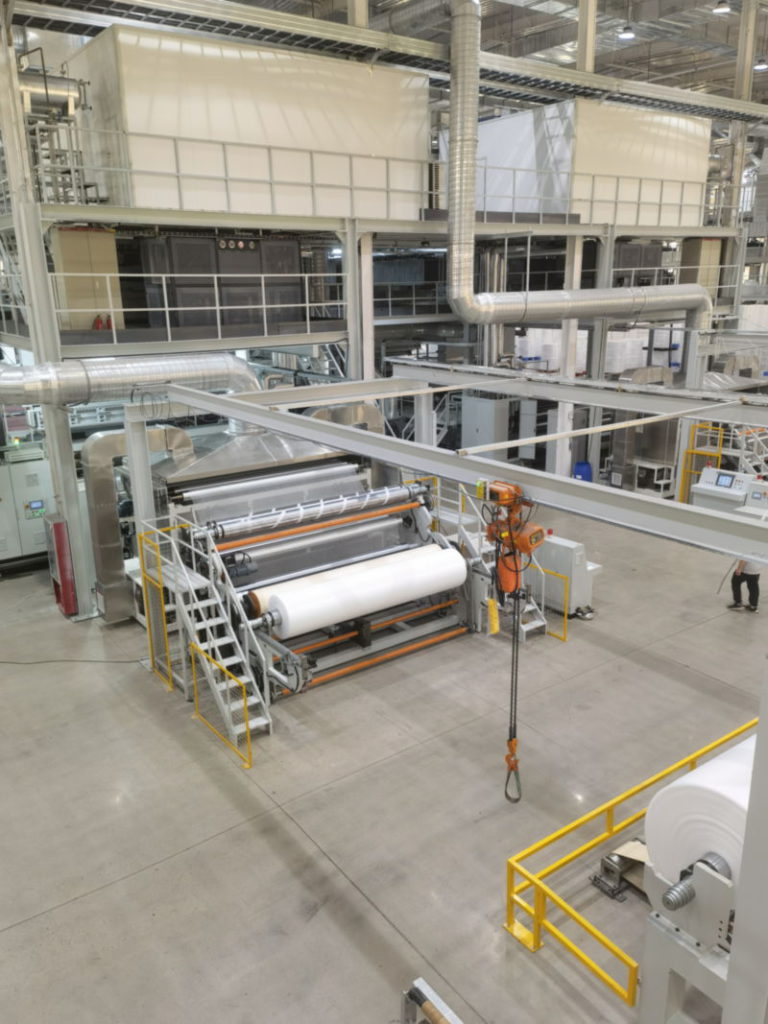How Much You Know About Nonwoven Fabric
A nonwoven materials from nonwoven fabric machine, refers to a material made from staple fibers and long fibers that are bonded together by various methods. It is a flat and flexible sheet with a non-directional fiber arrangement. Unlike traditional woven fabrics that are made from interlacing yarns, nonwoven fabrics are created through mechanical, térmico, or chemical processes that bind fibers together. The resulting material has a range of physical and chemical properties that make it suitable for a wide range of applications, including hygiene products, medical textiles, home furnishing fabrics, and many more. Nonwoven fabric can be made from natural or synthetic fibers or a combination of both. They are typically easy to handle, lightweight, and flexible. So that making them an ideal choice for many industrial and commercial applications. Except the topic about nonwoven fabric, we also introduce about China Spunbond Nonwoven Fabric Making Machine as you need.

Three Methods Of Manufacturing Fabric
Normally, three methods of manufacturing fabric: weaving, knitting, and the nonwoven process. If you may consider to involve in the business about non woven fabrics, firstly, choosing the right machines from nonwoven machinery manufacturers.
Nonwoven is a relatively new process for fabric production compared to other manufacturing methods. Non-woven by nonwoven fabric machine, refer to a type of textile fabric or a sheet that is created through the use of a fibrous layer. This can take the form of a carded web, fiber web, or any other combination of randomly oriented fibers or threads. It may be as mixed with both textile and non-textile materials. Such as woven fabrics, plastic films, foam layers, or metal foils. The resulting product is mechanically bound or chemically bonded to create a durable textile product.
There are two main classifications for nonwoven fabric, which are based on their manufacturing techniques and structures. The figures below illustrate the classification of nonwovens according to their production methods.
Techniques For Manufacturing Nonwoven Fabric By Nonwoven Fabric Machine:
The process of manufacturing nonwoven involves two consecutive machines that perform web laying and web bonding in a continuous manner. Typically, the processes involved in creating nonwoven materials can be split into two fundamental stages: firstly, the formation of a web, and secondly, the bonding of the fibers in that web. The formation of webs in nonwoven production is an essential factor that significantly affects the performance of the final product.
Web formation can be achieved through three primary techniques; namely, dry laid, wet laid, and polymer laid. The second type is divided into spun laid and melt blown web formations, which are highly suitable for synthetic polymers. Chemical, térmico, and mechanical are the three fundamental types of bonding. Mechanical processes can effectively bond natural fiber webs without the use of any additives. Chemical or thermal bonding necessitates the use of an extra binder polymer or synthetic fiber. Enquanto isso, referring to the consecutive machines, you have to contact with leading nonwoven machinery manufacturers from China.
Production Process Of Web Formation:
The process of laying staple fiber-based webs, known as Dry Laid or Air Laid, comprises three key stages. The preparation of the fibers involves opening and mixing, followed by the formation of a web through the use of either carding or air-lay processes. The final step is stacking the web through either parallellay, cross-lay, or perpendicular-lay methods.
The dry-laid process typically utilizes traditional staple fibers, which typically measure between 12 and 100 mm in length, as its raw material. Textile carding machines or air laying machines from the classical fabricantes de máquinas não tecidas, are utilized to mechanically separate and align the staple fibers, which are necessary for the creation of a fiber web. Carding aims to meticulously divide the fiber stock into separate fibers while minimizing damage to the fibers and fully integrating different varieties of fibers through opening and blending. Typically, during the carding process, the fibers tend to be aligned more in the longitudinal direction rather than the transverse direction. Cross lapping is a method that can be used to generate additional diverse web configurations.
China Spunbond Nonwoven Fabric Making Machine
Spunbond nonwoven fabric is a type of fabric that is made using a unique manufacturing process. The Spunbond nonwoven fabric making machine is used to produce this type of fabric. In this article, we will take a closer look at the Spunbond nonwoven fabric making machine and how it works.
O China Spunbond nonwoven fabric making machine is a complex piece of equipment that is used to produce nonwoven fabric. Nonwoven fabric is a type of fabric that is made by bonding together fibers using heat and pressure, rather than weaving or knitting them together. Spunbond nonwoven fabric is made by extruding molten polymer through spinnerets, which are small holes in a metal plate. As the polymer is extruded, it is cooled and solidified, forming filaments. These filaments are then bonded together using heat and pressure to create a strong, durable fabric.
